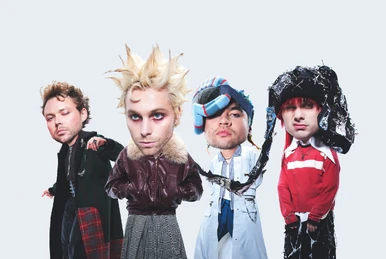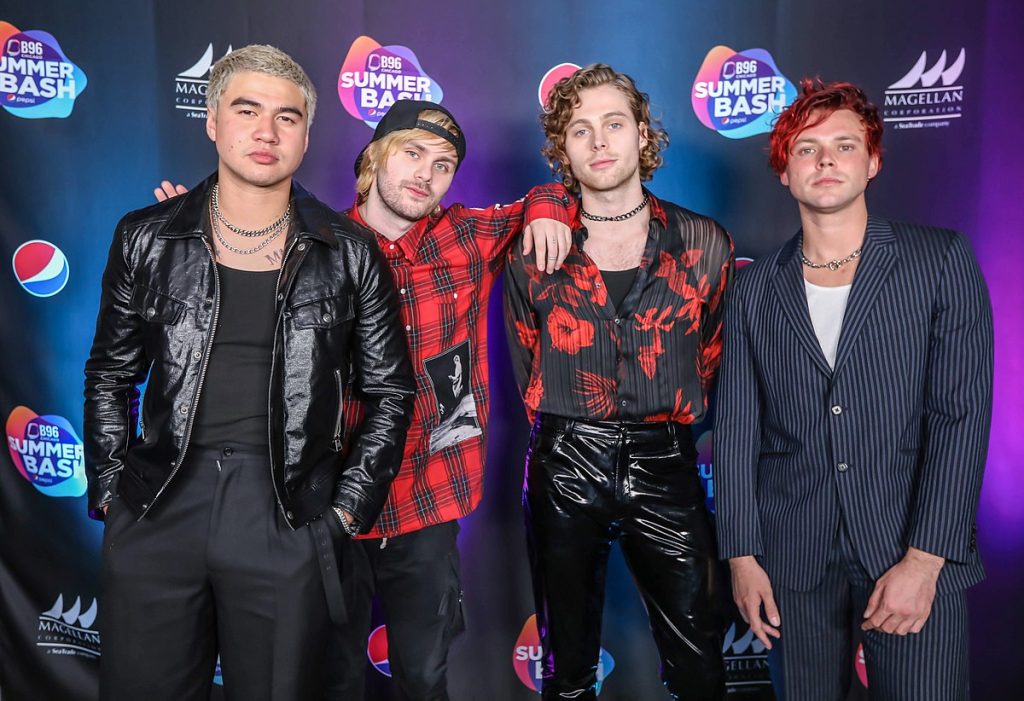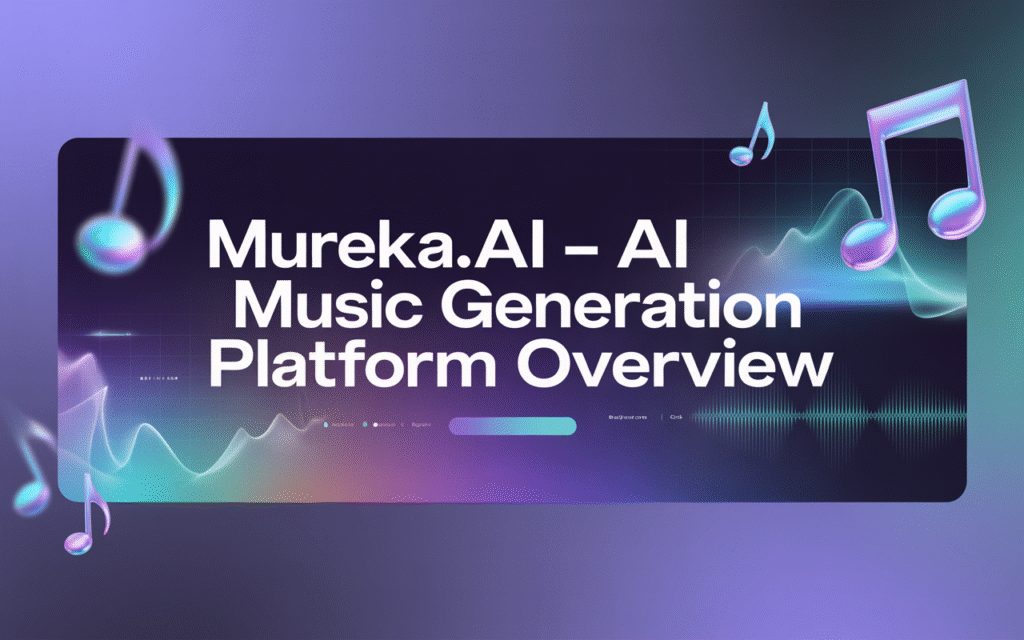After a few years focused on solo projects and their introspective album 5SOS5, Australian pop-rock powerhouse 5 Seconds of Summer have returned with a bang. Their new single, “NOT OK,” is an electrifying, chaotic, and unapologetic anthem that signals a bold new chapter for the band, and I’m here for all of it.
What is “NOT OK”?
“NOT OK” is the explosive lead single from 5 Seconds of Summer‘s sixth studio album, Everyone’s a Star!, released on September 24, 2025. The track immediately captured attention with its high-octane energy and genre-bending sound, marking the band’s first release under their new deal with Republic Records and setting a defiant tone for their new era.

A Glimpse into “NOT OK”: Lyrics and Creative Origins
The song dives headfirst into the theme of embracing one’s darker, more impulsive side. As I see it, it’s a candid exploration of how certain relationships can unlock a wilder, more reckless part of ourselves. The lyrics are a whirlwind of desire, temptation, and exhilarating chaos. In a statement, frontman Luke Hemmings described the track as having “the older 5 Seconds of Summer energy, but it’s different,” adding, “Lyrically, it’s about letting out the darker side of yourself and embracing it.” (Source: Rock Sound, 2025-09-24).
“NOT OK” Lyrics (Chorus):
Hey, I'm not okay
I like the darker side of me, that part of me
Comes out to play when I'm with you, you
(Bite, bite, bite) Bite the apple, baby
Hey, I'm not okay
It's like a hammer to the brain, all my insane
Comes out to play when I'm with you, you
(Bite, bite, bite) Bite the apple, baby
This chorus perfectly encapsulates the song’s central conflict: the intoxicating pull of a relationship that feels both destructive and liberating. It’s a theme many of us can relate to, that thrilling dance on the edge of reason.

Musical Style and Production Analysis
From a production standpoint, “NOT OK” is a masterclass in controlled chaos. The band reunited with producer Jason Evigan, known for his work with Maroon 5 and Justin Bieber, who also helmed the standout track “Bad Omens” from their previous album. Together, they’ve crafted a sound that is both a throwback and a leap forward.
The track is a high-energy fusion of pop-rock, electronica, and alt-rock aggression. The band cited influences like The Prodigy, N.E.R.D., and Gorillaz, and you can hear it in the DNA of the song. The production is dense and intentionally imperfect, prioritizing raw energy over polished perfection. This is a significant pivot from the more refined sound of their recent work.
| Musical Element | Analysis |
|---|---|
| Rhythm Section | The song is driven by a relentless, pulsating drum beat from Ashton Irwin and a zesty, melodic bassline from Calum Hood. The percussion is rave-ready, with crashing cymbals and staggered rhythms that create a sense of urgency. |
| Vocals | Luke Hemmings delivers the verses with a sharp, almost rap-esque cadence, a new style for him. The chorus explodes into an anthemic group chant, designed for massive crowd singalongs. Michael Clifford’s harmonies add texture, and he even takes the lead in the final chorus, a fantastic production choice. |
| Guitars & Synths | Fuzzy, distorted guitar riffs clash with hypnotic synth lines. The production embraces distortion as a feature, creating a sound that feels both heavy and danceable, reminiscent of early 2000s pop-punk meeting an underground rave. |
| Structure | While following a verse-pre-chorus-chorus structure, the song takes creative detours, most notably with Ashton’s spoken-word interlude. This break in the musical intensity adds a layer of confessional intimacy before the track dives back into its frenetic energy. |
This blend of raw rock elements with electronic production makes “NOT OK” feel incredibly versatile. I can easily imagine this track tearing up a festival stage or fueling the energy in a dark, sweaty club. It’s a testament to their growth as musicians and their willingness to experiment.
A Deeper Look into the “NOT OK” Lyrics
The lyrics of “NOT OK” are a fascinating exploration of duality and temptation. They paint a vivid picture of a relationship that acts as a catalyst for unleashing a hidden, “shadow side.” Let’s break down some of the key themes and symbols.
The Shadow Self and Dual Identity
The song opens with the line, “Inside every one of us, a shadow side / I call it my better side.” This immediately sets up the central theme. The narrator doesn’t see this darker part as something to be suppressed but as an exhilarating, perhaps even superior, version of themselves. This “better side” only emerges “when I’m with you,” highlighting the transformative and potentially dangerous power of the relationship.
Temptation and the “Bite the Apple” Metaphor
The recurring line, “Bite the apple, baby,” is a powerful and direct symbol. It’s an obvious nod to the biblical story of Adam and Eve, representing a willing surrender to temptation. It’s not about being tricked into a bad decision; it’s about consciously choosing the forbidden fruit because the experience is too alluring to resist. This act of “biting the apple” is framed as a shared transgression, a pact between the two people in the song.
The Cycle of Exhilaration and Guilt
Calum’s verse, “Oh my god, I feel invincible / And when the sun comes up, I feel despicable,” perfectly captures the emotional whiplash of this experience. There’s the god-like feeling of invincibility in the heat of the moment, followed by the inevitable crash of guilt and self-loathing when reality sets in. This cycle is addictive, and the song’s structure, which loops back on itself, mirrors this emotional rollercoaster. There’s no neat resolution, just a continuous loop of desire and consequence.
| Lyric/Motif | Symbolic Meaning | Emotional Impact |
|---|---|---|
| “I like the darker side of me” | Embracing one’s hidden, impulsive nature. | A sense of liberation and self-acceptance, even if it’s for a “flawed” part of oneself. |
| “Bite the apple, baby” | A conscious choice to give in to temptation; a shared act of rebellion. | Thrilling, risky, and conspiratorial. |
| “It’s like a hammer to the brain” | The overwhelming, almost violent intensity of the feeling. | Chaotic, disorienting, and all-consuming. |
| “I feel invincible / I feel despicable” | The extreme highs and lows of the experience. | Highlights the emotional instability and the addictive nature of the cycle. |
| “I said I love you, but I didn’t really mean it” | A moment of impulsive, perhaps regrettable, confession during the chaos. | Adds a layer of confusion, regret, and emotional messiness. |
Ashton’s spoken-word interlude adds another layer of raw honesty. The rambling, stream-of-consciousness style feels like a late-night confession, a moment of unfiltered thought amidst the chaos. Lines like, “I said I love you, but I didn’t really mean it / I, I don’t think, but / Anyways, turn it up,” perfectly capture the confusion and the impulse to drown out difficult feelings with more noise, more intensity. It’s a brilliantly written section that makes the song feel incredibly real and relatable.
How to Create a “NOT OK”-Style Track with Mureka
Inspired by the chaotic energy of “NOT OK”? As someone who spends a lot of time exploring AI music tools, I can tell you that platforms like Mureka are perfect for capturing this kind of vibe. You can blend raw rock energy with cutting-edge electronic sounds to create something truly unique. Here’s how I’d approach it.

Step 1: Setting the Foundation with an AI Prompt
The first step is to give the AI a clear direction. I’d start by heading to Mureka’s creation page and using a detailed prompt. The key is to be specific about the style, mood, and instrumentation.
Example Prompt: “Create a 3-minute high-energy pop-rock track. BPM: 140. Key: E minor. Inspired by 5 Seconds of Summer’s ‘NOT OK’ and The Prodigy. Feature a heavy, distorted guitar riff, a driving and melodic bassline, and aggressive, rave-style electronic drums. The mood should be chaotic, rebellious, and slightly dark but danceable. Include a breakdown section with a spoken-word vocal.”
This prompt gives Mureka’s AI enough information to generate a solid foundation that captures the core elements of the “NOT OK” sound.
Step 2: Generating and Refining the Stems
Mureka will generate individual stems for drums, bass, guitar, synths, and vocals. This is where the real fun begins. I can listen to each part and decide what works. Maybe the AI-generated drum beat is perfect, but I want a grittier guitar tone. With Mureka’s editor, I can swap out instruments, tweak melodies, or even upload my own recorded guitar riff as a reference to guide the AI.
For a song like “NOT OK,” the bassline is crucial. I would pay close attention to the generated bass stem, ensuring it’s not just a root-note-following part but a melodic and rhythmic force in its own right, just like Calum Hood’s playing.
Step 3: Layering and Human-AI Collaboration
The magic of modern music production is in the collaboration between human creativity and AI efficiency. I would use the AI-generated track as my canvas. I might record my own vocals over the top, adding the raw emotion that AI is still learning to replicate. Or, I could use Mureka’s voice cloning feature to experiment with different vocal textures.
The spoken-word bridge in “NOT OK” is a perfect example of where human performance shines. I could record my own spoken part and layer it over a sparse, atmospheric bed generated by the AI. This hybrid approach, combining the best of both worlds, is how you can create something that feels both professionally produced and deeply personal. For more inspiration, you can check out some other AI generated music examples to see what’s possible.

The Bigger Picture: AI Music and the Future of Creativity
The release of a song like “NOT OK” in 2025, with its complex, layered production, comes at a time when AI’s role in music is a hot topic. It makes me think about the broader trends and what it means for artists like us.
AI as a Creative Partner, Not a Replacement
For years, the fear has been that AI would replace human musicians. But as I see it, the reality is far more exciting. AI is becoming an indispensable creative partner. It can break through writer’s block by offering endless variations of melodies and chord progressions. It can handle the tedious parts of production, freeing up artists to focus on the bigger picture: the emotion, the story, and the performance.
The process of creating music with AI is a dialogue. We guide the AI with our ideas, and it responds with possibilities we might never have considered. This collaborative loop is where true innovation happens.
The Principles of AI Music Generation
How does it all work? At its core, AI music generation relies on deep learning models, often Transformers or Generative Adversarial Networks (GANs). These models are trained on vast datasets of existing music.
- Data Analysis: The AI “listens” to thousands of hours of music, learning the rules of harmony, rhythm, melody, and structure across different genres.
- Pattern Recognition: It identifies the patterns that make a pop song catchy or a rock song powerful.
- Music Creation: Using these learned patterns, the AI generates new musical pieces that are statistically similar to the data it was trained on, but are entirely original compositions.
The sophistication of these models is growing exponentially. They can now understand nuanced prompts, generate coherent long-form structures, and even mimic the style of specific artists or eras with startling accuracy.

Conclusion: “NOT OK” and the Dawn of a New Creative Age
5 Seconds of Summer’s “NOT OK” is more than just a great song; it’;s a reflection of the current moment in music. It’s chaotic, genre-defying, and unapologetically bold—qualities that also define the emerging landscape of AI-assisted music creation. It shows that even an established band can reinvent their sound and push boundaries, embracing a more reckless and experimental spirit.
For creators, platforms like Mureka offer the tools to do the same. Whether you’re a seasoned musician or just starting, you can harness the power of AI to explore new sonic territories, just as 5SOS did with “NOT OK.” It’s a thrilling time to be making music, and I can’t wait to hear what we all create next. What are your thoughts on using AI in your creative process? Let me know in the comments!

Frequently Asked Questions (FAQ)
1. What album is “NOT OK” by 5 Seconds of Summer on?
“NOT OK” is the lead single from 5 Seconds of Summer‘s sixth studio album, titled Everyone’s a Star!, which was released on November 14, 2025. (Source: uDiscoverMusic, 2025-09-24)
2. Who wrote and produced “NOT OK”?
The song was written by all four band members (Luke Hemmings, Calum Hood, Ashton Irwin, Michael Clifford) along with JHart, Sarah Hudson, Jason Evigan, and Mark Schick. It was produced by Jason Evigan and Mark Schick. (Source: Wikipedia, 2025-11-04)
3. What is the meaning behind the “NOT OK” lyrics?
The Not OK lyrics explore the theme of embracing one’s “shadow side” or darker impulses, often triggered by an intense and thrilling relationship. The song uses metaphors like “biting the apple” to symbolize a willing surrender to temptation and desire.
4. What are Mureka’s subscription plans?
Mureka offers flexible plans for different creative needs. Here’s a breakdown of the 2025 subscription options:
| Feature | Basic Music & Speech | Pro |
|---|---|---|
| Price | $8/month (billed annually at $96) | $24/month (billed annually at $288) |
| Monthly Credits | 400 songs or 200 mins of speech | 1,600 songs or 800 mins of speech |
| Downloads | MP3 | MP3, WAV, Instrumental, Stems |
| Commercial License | Yes | Yes |
| Advanced Editing | No | Yes (Region, Melody Extension) |
| Reference Audio Upload | No | Yes |
| Voice Cloning | No | Yes (for commercial projects) |
5. Can I use music created with Mureka for commercial projects?
Yes, both the Basic and Pro plans on Mureka include a commercial license, allowing you to use the music you create in your projects. However, it’s always recommended to review the specific terms of service for detailed usage rights.
6. What makes Mureka a good AI music generator for creating pop-rock music?
Mureka’s strength lies in its detailed prompting capabilities and stem-based generation. You can specify genres, moods, instruments, and even influential artists (like 5 Seconds of Summer) to guide the AI. The ability to download individual stems (on the Pro plan) allows for deep customization, letting you blend AI-generated elements with your own recordings for a professional, hybrid sound.
This report is for informational and educational purposes only.
The views and interpretations expressed are those of the author and do not necessarily reflect the official position of any mentioned artists or entities.
All information is sourced from publicly available data and is accurate to the best of our knowledge as of the publication date.
